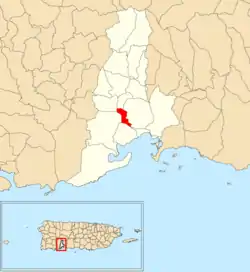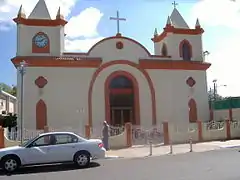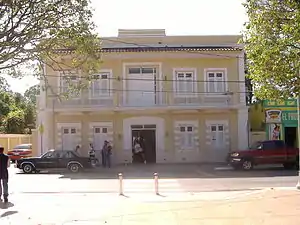Guayanilla barrio-pueblo
Guayanilla barrio-pueblo is an urban barrio and the administrative center (seat) of Guayanilla, a municipality of Puerto Rico. Its population in 2010 was 3,757.[1][4][5][6]
Guayanilla barrio-pueblo
Barrio Pueblo Guayanilla | |
|---|---|
Municipality Seat[1] | |
 Statue of Luis Muñoz Marín, the 1st elected governor of Puerto Rico | |
 Location of Guayanilla barrio-pueblo within the municipality of Guayanilla shown in red | |
 Guayanilla barrio-pueblo Location of Puerto Rico | |
| Coordinates: 18°01′22″N 66°47′28″W[2] | |
| Commonwealth | |
| Municipality | |
| Area | |
| • Total | 0.54 sq mi (1.4 km2) |
| • Land | 0.54 sq mi (1.4 km2) |
| • Water | 0 sq mi (0 km2) |
| Elevation | 52 ft (16 m) |
| Population (2010) | |
| • Total | 3,757 |
| • Density | 6,957.4/sq mi (2,686.3/km2) |
| Source: 2010 Census | |
| Time zone | UTC−4 (AST) |
As was customary in Spain, in Puerto Rico, the municipality has a barrio called pueblo which contains a central plaza, the municipal buildings (city hall), and a Catholic church. Fiestas patronales (patron saint festivals) are held in the central plaza every year.[7][8]
Features and demographics
Guayanilla barrio-pueblo has .54 square miles (1.4 km2) of land area and no water area. In 2010, its population was 3,757 with a population density of 6,957.4 inhabitants per square mile (2,686.3/km2).
| Historical population | |||
|---|---|---|---|
| Census | Pop. | %± | |
| 1900 | 973 | — | |
| 1910 | 1,141 | 17.3% | |
| 1920 | 1,434 | 25.7% | |
| 1930 | 2,044 | 42.5% | |
| 1940 | 1,266 | −38.1% | |
| 1950 | 3,113 | 145.9% | |
| 1980 | 5,611 | — | |
| 1990 | 5,238 | −6.6% | |
| 2000 | 4,832 | −7.8% | |
| 2010 | 3,757 | −22.2% | |
| U.S. Decennial Census[9] 1899 (shown as 1900)[10] 1910-1930[11] 1930-1950[12] 1980-2000[13] 2010[14] | |||
Notable landmarks
The Parroquia Inmaculada Concepción Roman Catholic church, which was located across from the central plaza,[15] was destroyed during earthquakes in late 2019 and early 2020.
The central plaza, or square, is a place for official and unofficial recreational events and a place where people can gather and socialize from dusk to dawn. The Laws of the Indies, Spanish law, which regulated life in Puerto Rico in the early 19th century, stated the plaza's purpose was for "the parties" (celebrations, festivities) (Spanish: a propósito para las fiestas), and that the square should be proportionally large enough for the number of neighbors (Spanish: grandeza proporcionada al número de vecinos). These Spanish regulations also stated that the streets nearby should be comfortable portals for passersby, protecting them from the elements: sun and rain.[7]
History
Puerto Rico was ceded by Spain in the aftermath of the Spanish–American War under the terms of the Treaty of Paris of 1898 and became a territory of the United States. In 1899, the United States conducted its first census of Puerto Rico finding that the population of Pueblo barrio was 973.[16]
Gallery
 The Guayanilla Catholic Church is seen standing before its destruction by an earthquake in 2020
The Guayanilla Catholic Church is seen standing before its destruction by an earthquake in 2020 Guayanilla City Hall
Guayanilla City Hall
See also
References
- Puerto Rico:2010:population and housing unit counts.pdf (PDF). U.S. Dept. of Commerce, Economics and Statistics Administration, U.S. Census Bureau. 2010.
- "US Gazetteer 2019". US Census. US Government.
- U.S. Geological Survey Geographic Names Information System: Guayanilla barrio-pueblo
- Picó, Rafael; Buitrago de Santiago, Zayda; Berrios, Hector H. Nueva geografía de Puerto Rico: física, económica, y social, por Rafael Picó. Con la colaboración de Zayda Buitrago de Santiago y Héctor H. Berrios. San Juan Editorial Universitaria, Universidad de Puerto Rico,1969.
- Gwillim Law (20 May 2015). Administrative Subdivisions of Countries: A Comprehensive World Reference, 1900 through 1998. McFarland. p. 300. ISBN 978-1-4766-0447-3. Retrieved 25 December 2018.
- "US Census Barrio-Pueblo definition". factfinder.com. US Census. Archived from the original on 13 May 2017. Retrieved 5 January 2019.
- Santullano, Luis A. (10 March 2019). Mirada al Caribe. 54. Colegio de Mexico. pp. 75–78. doi:10.2307/j.ctvbcd2vs.12. JSTOR j.ctvbcd2vs.12.
- Pariser, Harry S. (2003). Explore Puerto Rico, Fifth Edition. San Francisco: Manatee Press. pp. 52–55. Retrieved 10 February 2019.
- "U.S. Decennial Census". United States Census Bureau. Archived from the original on February 13, 2020. Retrieved September 21, 2017.
- "Report of the Census of Porto Rico 1899". War Department Office Director Census of Porto Rico. Archived from the original on July 16, 2017. Retrieved September 21, 2017.
- "Table 3-Population of Municipalities: 1930 1920 and 1910" (PDF). United States Census Bureau. Archived (PDF) from the original on August 17, 2017. Retrieved September 21, 2017.
- "Table 4-Area and Population of Municipalities Urban and Rural: 1930 to 1950" (PDF). United States Census Bureau. Archived (PDF) from the original on August 30, 2015. Retrieved September 21, 2014.
- "Table 2 Population and Housing Units: 1960 to 2000" (PDF). United States Census Bureau. Archived (PDF) from the original on July 24, 2017. Retrieved September 21, 2017.
- Puerto Rico:2010:population and housing unit counts.pdf (PDF). U.S. Dept. of Commerce Economics and Statistics Administration U.S. Census Bureau. 2010. Archived (PDF) from the original on 2017-02-20. Retrieved 2019-08-02.
- Mari Mut, José A. (2013-08-28). Los Pueblos de Puerto Rico y Las Iglesias de Sus Plazas [The Pueblos of Puerto Rico, and the Churches of its Plazas] (PDF) (in Spanish). pp. 10–12. Retrieved 2020-12-14.
- Joseph Prentiss Sanger; Henry Gannett; Walter Francis Willcox (1900). Informe sobre el censo de Puerto Rico, 1899, United States. War Dept. Porto Rico Census Office (in Spanish). Imprenta del gobierno. p. 165.
- "Colapsa la Parroquia Inmaculada Concepción de Guayanilla tras el temblor". El Nuevo Dia. 7 January 2020.
- DeRoos, Dan. "Northeast Ohio researcher who once studied earthquakes in Puerto Rico gives perspective on current situation". www.cleveland19. Archived from the original on 7 January 2020. Retrieved 7 January 2020.